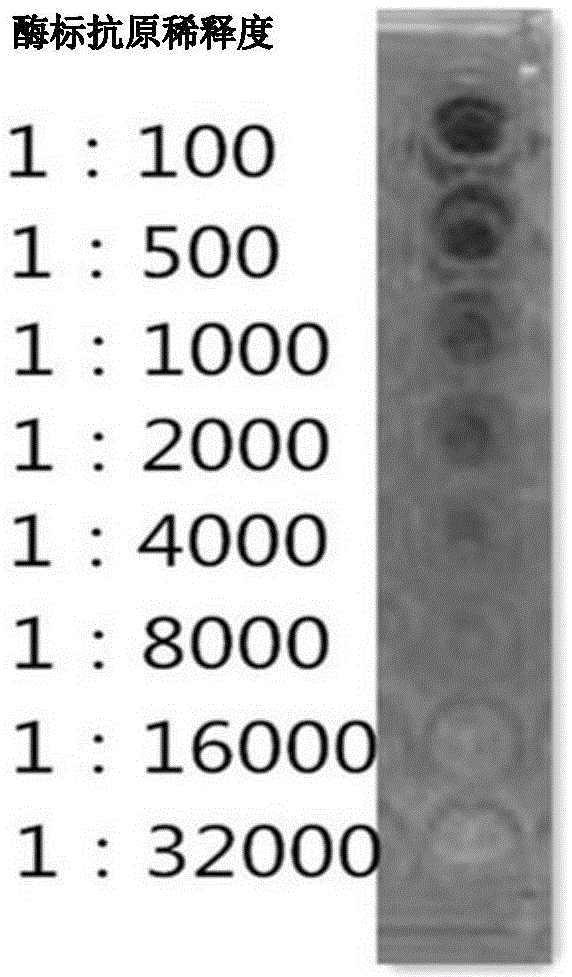Preparation of pesticide-carbaryl molecular-imprinting bionic rapid-detection test strip and application thereof
A technology of molecular imprinting and detection test paper, applied in biological testing, analytical materials, measuring devices, etc., can solve the problems of difficult to guarantee antibody specificity, long preparation period of biological antibody, limited application, etc. The results are obvious and intuitive, and the preparation process is simple.
- Summary
- Abstract
- Description
- Claims
- Application Information
AI Technical Summary
Problems solved by technology
Method used
Image
Examples
preparation example Construction
[0033] figure 1 It is a flow chart for the preparation of carbaryl molecularly imprinted bionic test strips.
[0034] figure 2 It is a schematic diagram of detection of carbaryl molecularly imprinted bionic test strip.
[0035] image 3 Schematic diagram for optimizing the detection of enzyme-labeled antigens, from image 3 It can be seen that the color gradually becomes lighter with the increase of enzyme-labeled antigen dilution.
[0036] Figure 4 Schematic diagram of reaction time optimization, from Figure 4 It can be seen that the color gradually becomes darker with the increase of reaction time.
[0037] Figure 5 Schematic diagram of the results of molecularly imprinted bionic test strips for different concentrations of carbaryl (from A to C, the color of the test paper gradually becomes lighter as the concentration of carbaryl increases).
Embodiment 1
[0039] Preparation of biomimetic rapid test strips for molecularly imprinted pesticide carbaryl:
[0040] A. Pretreatment of solid phase carrier: WhantmanNO.5 filter paper is pre-dried in a vacuum drying oven to remove moisture, immersed in 80% ethanol containing 0.5-0.6% γ-methacrylic acid oxypropyltrimethoxysilane (γ-MAPS) solution, fixed in a drying oven and cut into circular paper pieces with a certain diameter.
[0041] B. Preparation of carbaryl molecularly imprinted bionic test strip: template molecule (carbaryl), functional monomer (MAA), cross-linking agent (EGDMA) with a molar ratio of 1:4:4, initiator (content of 2-2.5% of the total mass of functional monomers and cross-linking agents) dissolved in chloroform, added to pre-treated paper sheets, degassed, thermally polymerized in a water bath at 55-60°C for 10-20h, and obtained carbaryl molecularly imprinted bionic test strips.
[0042] C. Removal of template molecules: Soxhlet extraction of template molecules with...
Embodiment 2
[0050] Green vegetables were selected as test samples, and carbaryl molecularly imprinted bionic test strips were prepared to detect the effect in actual samples by adding different concentrations of carbaryl.
[0051] Sample addition and recovery experiment 2: Weigh three 0.5g vegetable blank samples, add 1mL methanol, add 0.25, 0.5, 1mgkg -1 After shaking, react with carbaryl molecularly imprinted bionic test strips respectively, and at the same time add enzyme-labeled antigen diluent with a volume ratio of 1:1 (enzyme-labeled antigen dilution is 1:100-1:32000), react 1-50min. After washing, add substrate for color development and read analysis.
[0052] Using the test strip of Example 2 is easy to operate, and the test results are intuitive and easy to distinguish. The color of the carbaryl molecularly imprinted bionic test strips with different concentrations of carbaryl changed significantly compared with the green vegetable blank sample without adding, and the color be...
PUM
 Login to View More
Login to View More Abstract
Description
Claims
Application Information
 Login to View More
Login to View More - R&D
- Intellectual Property
- Life Sciences
- Materials
- Tech Scout
- Unparalleled Data Quality
- Higher Quality Content
- 60% Fewer Hallucinations
Browse by: Latest US Patents, China's latest patents, Technical Efficacy Thesaurus, Application Domain, Technology Topic, Popular Technical Reports.
© 2025 PatSnap. All rights reserved.Legal|Privacy policy|Modern Slavery Act Transparency Statement|Sitemap|About US| Contact US: help@patsnap.com



